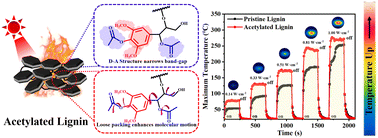Mechanism study of the photothermal function of lignin: the effect of electron-withdrawing groups†
Abstract
As a new type of green photothermal material, lignin exhibits an excellent photothermal effect due to its abundant aromatic rings and π–π conjugated structure. To develop value-added applications of lignin in the photothermal field, it is important to explore strategies for regulating the photothermal conversion of lignin. In this work, the photothermal effect of lignin was improved significantly through modification with an electron-withdrawing group. The introduction of acetyl resulted in the formation of an electron donor–acceptor (D–A) structure in lignin and enhanced the light absorption ability. The intermolecular interaction among lignin molecules also decreased after modification with acetyl groups, leading to enhanced non-radiative decay induced by molecular motion. Under 808 nm laser irradiation at 0.51 W cm−2, the photothermal conversion efficiency of acetylated lignin (ACAL) reached as high as 73.2%, which was 37% higher than that of unmodified lignin. This study provides a new strategy to enhance the photothermal effect of lignin and deepens the understanding of the lignin photothermal mechanism.



 Please wait while we load your content...
Please wait while we load your content...